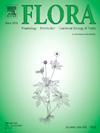薯蓣属(薯蓣科)微块茎发育的形态学和组织学描述
IF 1.8
4区 生物学
Q3 ECOLOGY
引用次数: 0
摘要
微块茎是传统栽培系统中块茎分割、储存和播种的替代产品。尽管已有关于生产所需条件的研究,但描述性分析很少,而且主要集中在微块茎中存在的淀粉。为了解决信息缺乏的问题,本研究旨在描述离体条件下不同薯蓣种和品种微块茎发育的初级阶段及其各阶段的解剖学变化。用Feulgen法对40个微管进行差异染色,并用共聚焦显微镜对其进行分析。这些结果描述了微块茎主要节段的形成和发育阶段,以及微块茎内传导系统的形成、淀粉颗粒积累的开始和微块茎组织的不同细胞。此外,疏花薯蓣的微块茎在形态上也存在差异,其呈细长、粗大的根状,而褐皮薯蓣的微块茎则呈球形至卵球形,略带紫色。本文章由计算机程序翻译,如有差异,请以英文原文为准。
Morphological and histological description of the development of microtubers of the genus Dioscorea (Dioscoreaceae)
Microtubers constitute a production alternative to tuber segmentation, storage, and sowing in traditional cultivation systems. Despite existing studies on the conditions necessary for production, descriptive analyses are scarce and have focused on the starches present in microtubers. To address the lack of information, this study aimed to describe the primary stages of microtuber development and the anatomical changes during each stage in different Dioscorea species and varieties produced under in vitro conditions. Forty microtubers were processed by differential staining using the Feulgen method and analyzed by confocal microscopy. The results describe the formation of the main microtuber segments and developmental stages, as well as the formation of the conduction systems within the microtuber, the start of starch granule accumulation, and the different cells of microtuber tissue. In addition, morphological differences were observed in the microtubers derived from Dioscorea sparsiflora, which exhibited an elongated, thickened root-like appearance, in contrast to the microtubers of Dioscorea alata, which were spherical to ovoid in shape and displayed a slight purple hue.
求助全文
通过发布文献求助,成功后即可免费获取论文全文。
去求助
来源期刊

Flora
生物-植物科学
CiteScore
3.30
自引率
10.50%
发文量
130
审稿时长
54 days
期刊介绍:
FLORA publishes original contributions and review articles on plant structure (morphology and anatomy), plant distribution (incl. phylogeography) and plant functional ecology (ecophysiology, population ecology and population genetics, organismic interactions, community ecology, ecosystem ecology). Manuscripts (both original and review articles) on a single topic can be compiled in Special Issues, for which suggestions are welcome.
FLORA, the scientific botanical journal with the longest uninterrupted publication sequence (since 1818), considers manuscripts in the above areas which appeal a broad scientific and international readership. Manuscripts focused on floristics and vegetation science will only be considered if they exceed the pure descriptive approach and have relevance for interpreting plant morphology, distribution or ecology. Manuscripts whose content is restricted to purely systematic and nomenclature matters, to geobotanical aspects of only local interest, to pure applications in agri-, horti- or silviculture and pharmacology, and experimental studies dealing exclusively with investigations at the cellular and subcellular level will not be accepted. Manuscripts dealing with comparative and evolutionary aspects of morphology, anatomy and development are welcome.
 求助内容:
求助内容: 应助结果提醒方式:
应助结果提醒方式:


